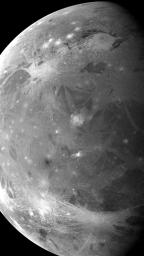
|
Completing a Global Map of Ganymede
- Click the image above for a larger view
- Full-Res JPEG (790 x 1413) (129.1 kB)
- Full-Res TIFF (790 x 1413) (763.1 kB)
Caption:
When NASA's two Voyager spacecraft passed through the Jupiter system in 1979, they captured many high resolution images of the Galilean satellites, but these encounters left some regions of these four largest Jovian moons poorly seen. One of the primary objectives of NASA's Galileo mission was to acquire images of areas that Voyager could not see. This is one such image, showing part of the leading hemisphere of Ganymede. Many fragmented regions of dark terrain split by lanes of bright grooved terrain cover the surface. Several bright young craters can be seen, including a linear chain of craters near the center of the image which may have resulted from the impact of a fragmented comet, similar to comet Shoemaker-Levy/9 which hit Jupiter in 1994.
North is to the top of the picture and the sun illuminates the surface from the left. The mosaic, centered at 0 degrees latitude and 285 degrees longitude, covers an area approximately 2800 by 5100 kilometers. The resolution is 3.6 kilometers per picture element. The images were taken on February 21, 1997 at 20 hours, 25 minutes, 29 seconds Universal Time at a range of 34,386 kilometers by the Solid State Imaging (SSI) system on NASA's Galileo spacecraft.
Background Info:
The Jet Propulsion Laboratory, Pasadena, CA manages the Galileo mission for NASA's Office of Space Science, Washington, DC.
This image and other images and data received from Galileo are posted on the World Wide Web, on the Galileo mission home page at URL http:// galileo.jpl.nasa.gov . Background information and educational context for the images can be found at http://www.jpl.nasa.gov/galileo/sepo .
Cataloging Keywords:
| Name | Value | Additional Values |
|---|---|---|
| Target | Ganymede | Jupiter |
| System | Jupiter | |
| Target Type | Satellite | Planet |
| Mission | Galileo | |
| Instrument Host | Galileo Orbiter | |
| Host Type | Orbiter | Flyby Spacecraft |
| Instrument | Solid-State Imaging (SSI) | |
| Detector | ||
| Extra Keywords | Crater, Grayscale, Impact, Map | |
| Acquisition Date | ||
| Release Date | 1998-07-15 | |
| Date in Caption | 1997-02-21 | |
| Image Credit | NASA/JPL/Brown University | |
| Source | photojournal.jpl.nasa.gov/catalog/PIA01606 | |
| Identifier | PIA01606 | |
